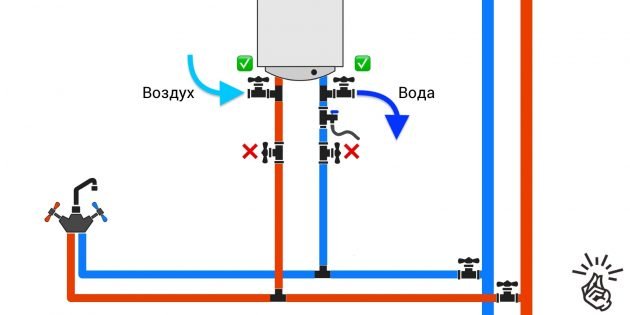Regardless of the reason, the discharge of the water heater storage is carried out according to the same algorithm.
In order not to get burned during operation, turn off the heating of the boiler and drain some of the hot water: the tank will fill with cold and the temperature will decrease. To save money, you can do this in advance by spending water on something you need.
For safety reasons, all manipulations with the water heater should be carried out only after complete disconnection from the mains. To do this, de-energize the corresponding machine in the electrical panel or remove the plug of the power wire from the outlet.
The next mandatory step is to block the supply at the entrance. If there is a tap on the cold water pipe next to the boiler, use it. If the strapping is done without such a tap, close the main cold water valve at the entrance to the apartment or house.
Owners of dwellings with central hot water supply must additionally shut off the hot water tap at the entrance.
Just open the hot water on the mixer and empty the boiler will not work due to the fact that when the water is consumed, the tank is filled at the same time. Cold water pushes out hot water — that's how it works. It would seem that it is enough to turn off the tap at the entrance so that the boiler does not fill up, but no. Everything is a little more complicated.

The hot water intake tube is located at the very top of the tank, because when heated, the liquid rises up. The supply nozzle, on the contrary, is located at the bottom — so the water layers do not mix. Therefore, when the supply is blocked, no more than a liter will merge from the mixer.
The water can be completely drained only through the supply tube. At the same time, it is necessary to ensure the flow of air into the tank so that no vacuum is created there and the liquid drains. Depending on the type of connection, this is done in different ways: from simply opening the tap to removing the fittings.

The most convenient scheme for draining. Thanks to the taps installed on the tees, it allows you to open air access to the tank and quickly empty it.

Not the worst connection option, which is still inferior in convenience to the previous one. A tee with a tap is installed only at the inlet, so you will have to let air into the tank through a mixer or by removing the pipe from the outlet fitting.

There is a variation of such a scheme without a tap at the outlet of the boiler. In fact, it is no different: the air is released in the same ways.

The most inconvenient strapping scheme is when the water heater is connected directly without tees and taps. We have only a safety valve with a drainage outlet at our disposal. Through it, though slowly, but you can also drain the water. In extreme cases, the valve is easy to remove, and then the flow will be much larger.